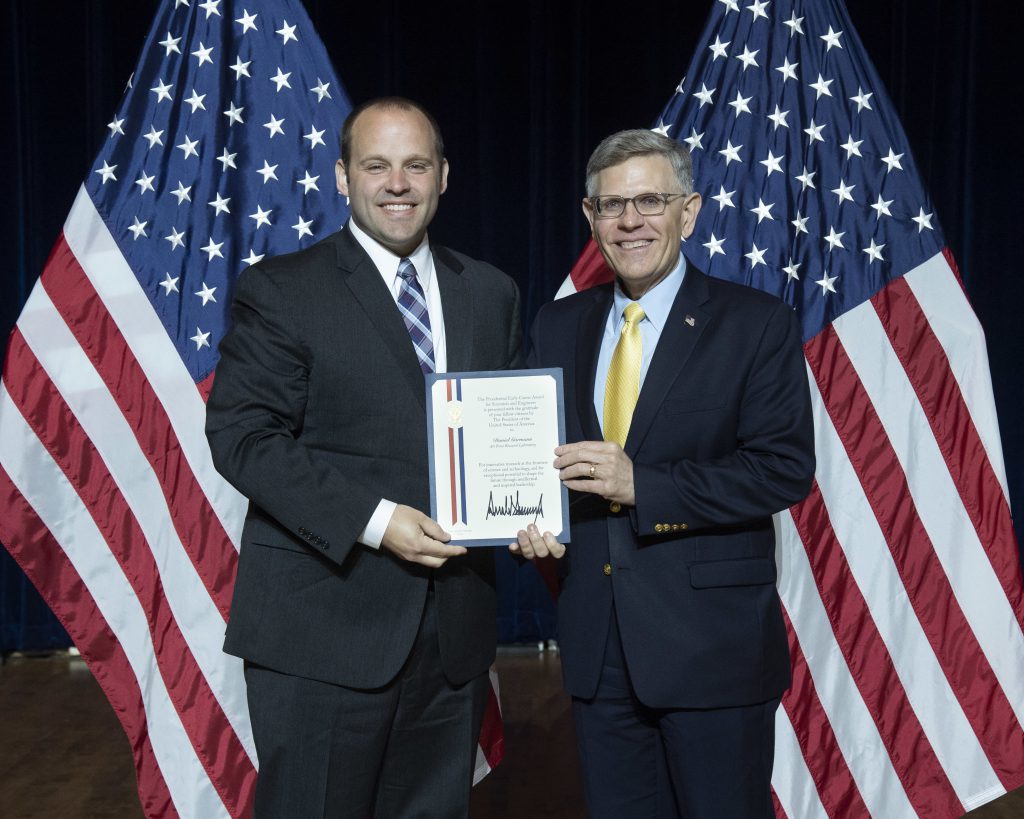AFRL aerodynamics expert honored with Presidential Early Career award
WRIGHT-PATTERSON AIR FORCE BASE, Ohio – Dr. Daniel Garmann of the Air Force Research Laboratory Aerospace Systems Directorate was honored with the prestigious Presidential Early Career Award for Scientists and Engineers at a July 25 ceremony in Washington, D.C.
Garmann, a senior research aerospace engineer, is an expert in the modeling, simulation, and behavior of air flows and their effect on the control and performance of aircraft. His work impacts vehicles from across the spectrum, from unmanned aircraft systems, to fighter jets, to hypersonic platforms.
Understanding complex aerodynamic flows over vehicle surfaces is critical to predicting aircraft performance. Unsteady, or turbulent, air flows can result in unfavorable conditions, including undue structural fatigue, noise, or inefficient operation. By using advanced computer modeling and simulation, AFRL researchers can pre-emptively determine the flow dynamics surrounding new designs or design changes.
Garmann’s work focuses on refining and advancing high-fidelity modeling and simulation tools. A noted expert in advanced computational aerosciences, he seeks to address and eliminate gaps in modeling and simulation technology. His research has spanned a broad range of Air Force platforms, positively impacting vehicle range and weight, fuel efficiency, structural integrity, maneuverability, and loiter time.
“There is an urgent need to accurately and effectively predict the complex unsteady aerodynamic interactions that ultimately translate into increased system risk and cost, as well as diminished performance,” Garmann said. “To discover, harness, or prevent such interactions is what will enable truly revolutionary future Air Force capabilities. Our group is addressing this pervasive challenge, and I am incredibly proud to be part of something so important to our Air Force mission.”
Throughout Garmann’s career, he has focused his work on aerodynamics and its effect on aircraft. Recently, he characterized for the first time the near- and far-wake behavior of wingtip vortices in flight conditions, providing critical insight into optimal formation flight. This research contributes to greater fuel efficiency, enhanced structural integrity, and improved controllability for groups of aircraft flying in formation. His efforts in this area have played an instrumental role in projects such as the Surfing Aircraft Vortices for Energy, or $AVE, program.
Additionally, Garmann developed guidelines and best practices for experimental/computational cross-validation that greatly reduce uncertainty in aircraft design, thereby enabling truly predictive simulation. The work helps reduce the need for costly flight testing early in the developmental process and lowers overall program risk.
Garmann also pioneered the development of robust, versatile, and massively parallel numerical simulation techniques for unsteady flows. This work has broadened the types of technologies that can be simulated with AFRL in-house tools and has increased the speed, accuracy, and reliability of high-fidelity simulations.
In addition to his current work in computational aerodynamics, Garmann also serves as principal investigator for an internationally-recognized group designated as an Air Force Office of Scientific Research Star team. This honor recognizes excellence in basic research and is bestowed upon no more than 10 percent of AFRL research activities.
He has also reached across industry, academia, and government to consult and collaborate on technical issues. Garmann represents AFRL externally on three national technical committees, and has been named an associate Fellow of the American Institute of Aeronautics and Astronautics. A recognized subject matter expert, he actively seeks to advance the body of knowledge within the scientific community, both within and outside the government sector.
“I am honored to have been selected as a PECASE recipient,” Garman said of the award. “It is incredibly humbling to have been considered amid all the amazing young researchers at AFRL and across the nation.”

